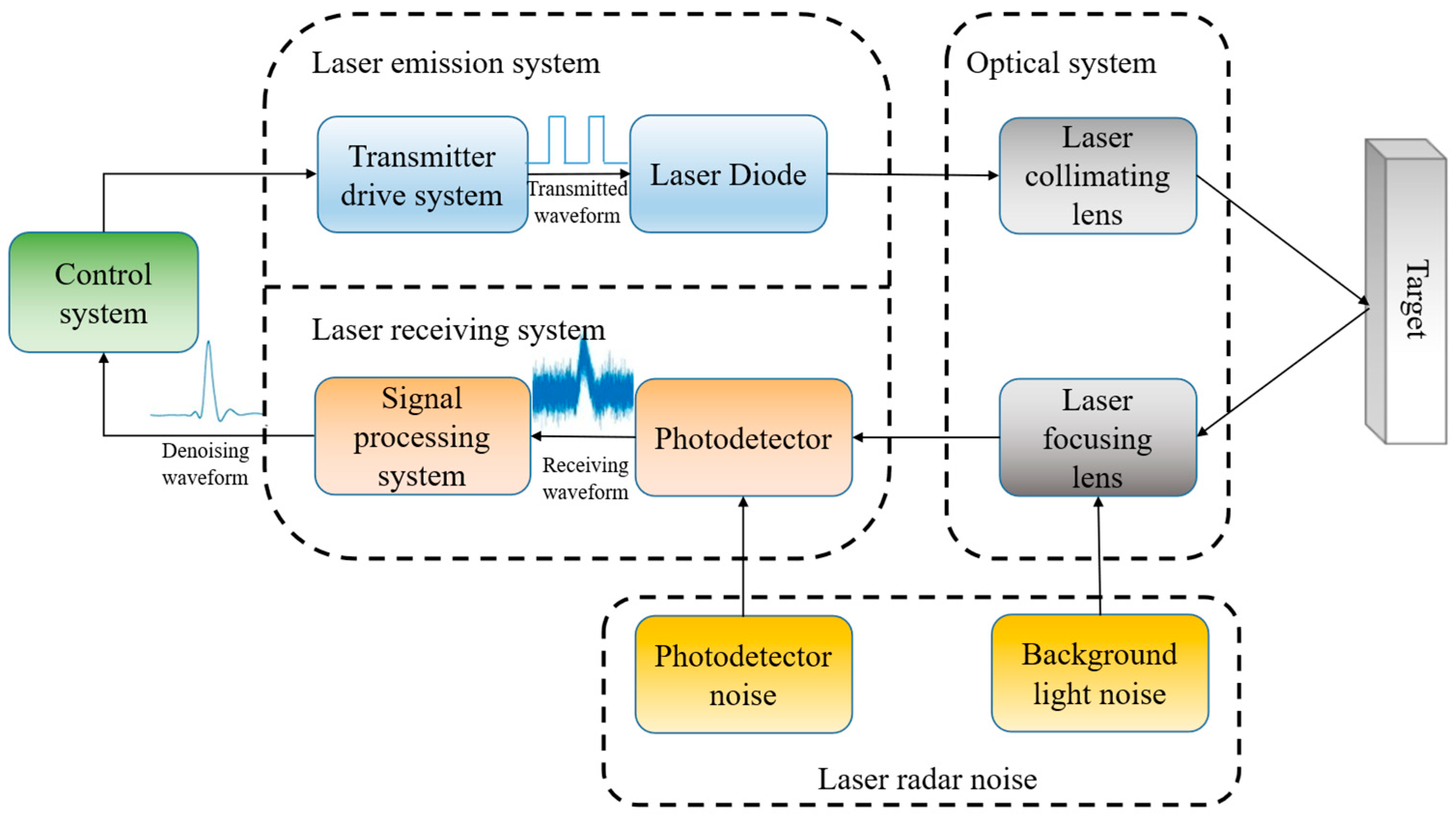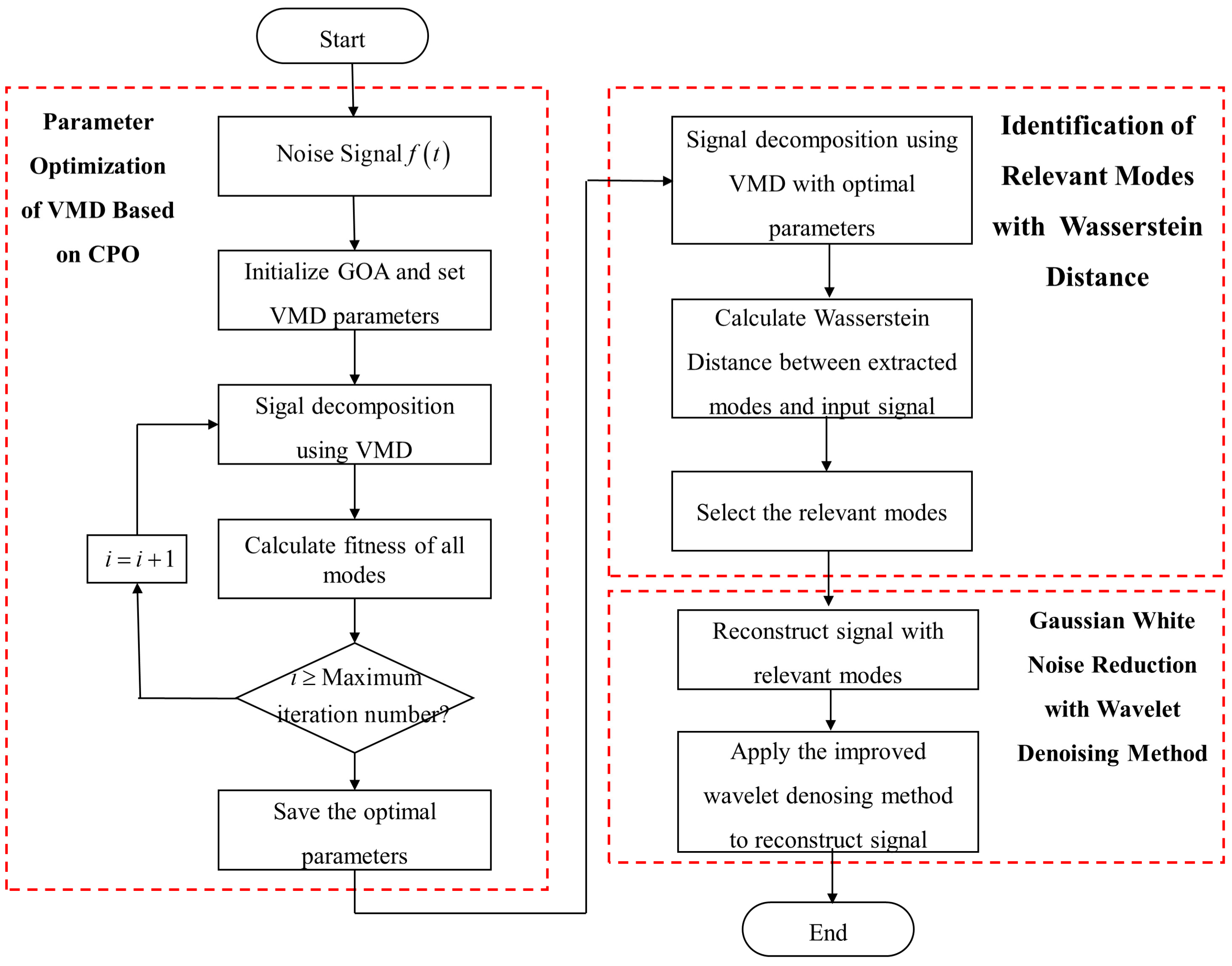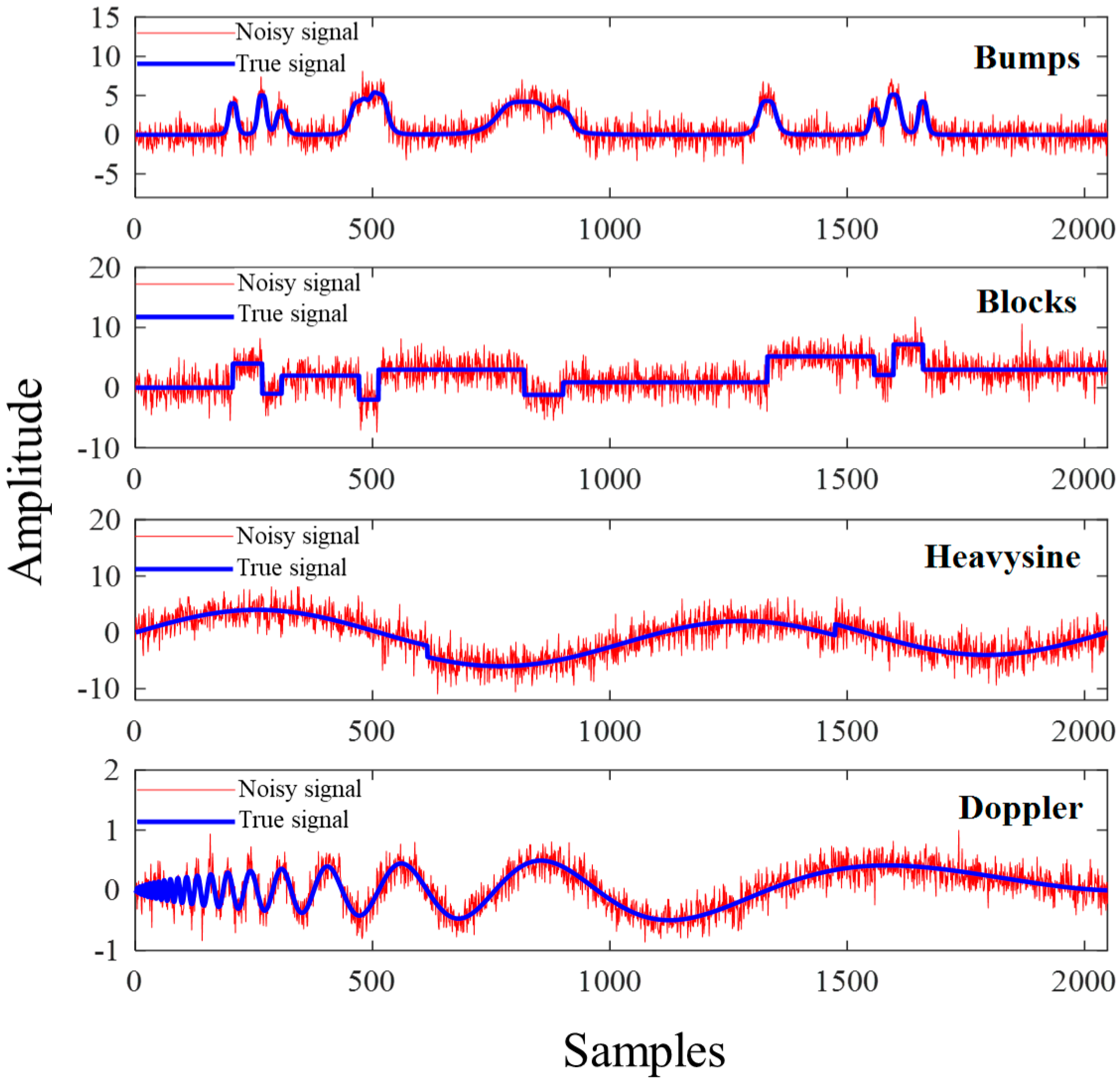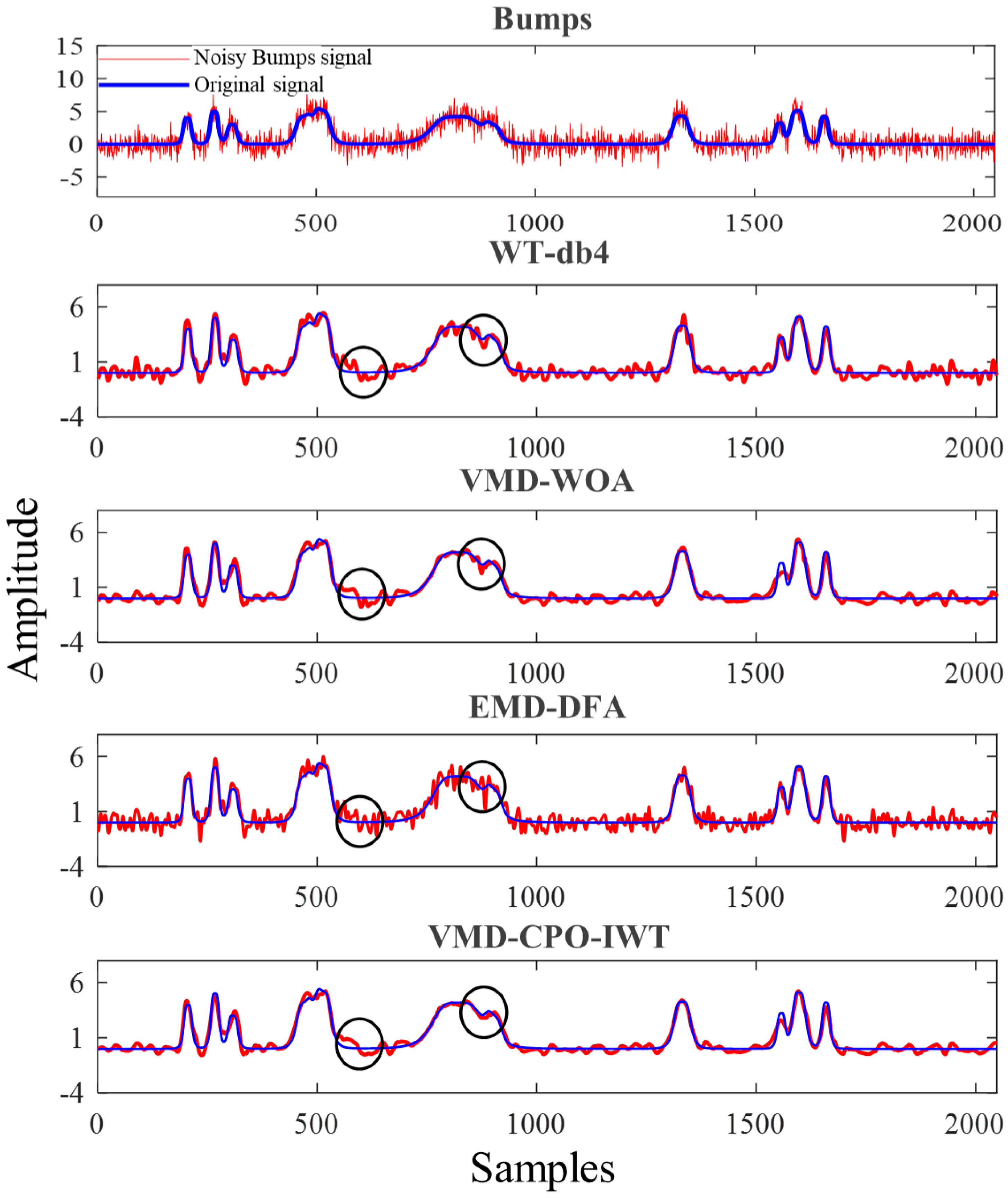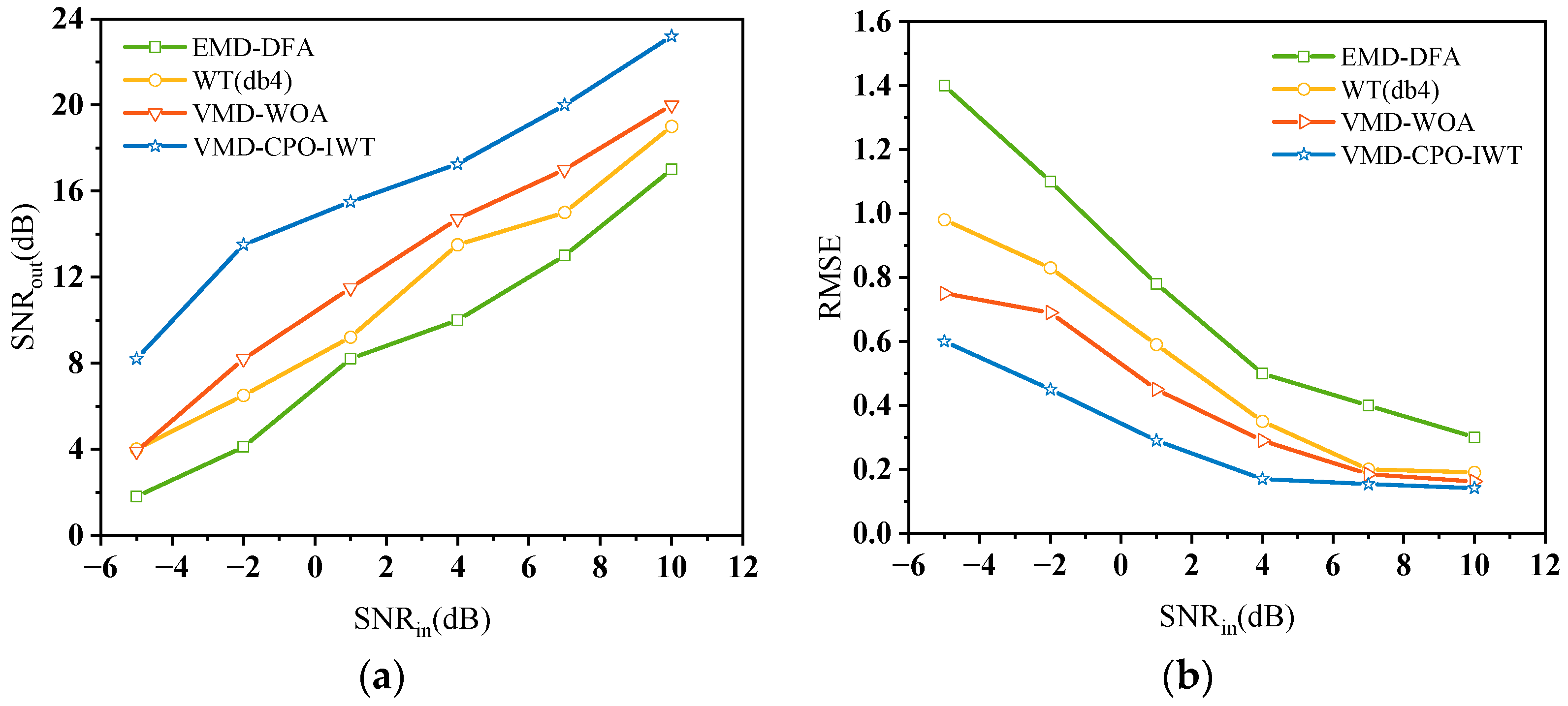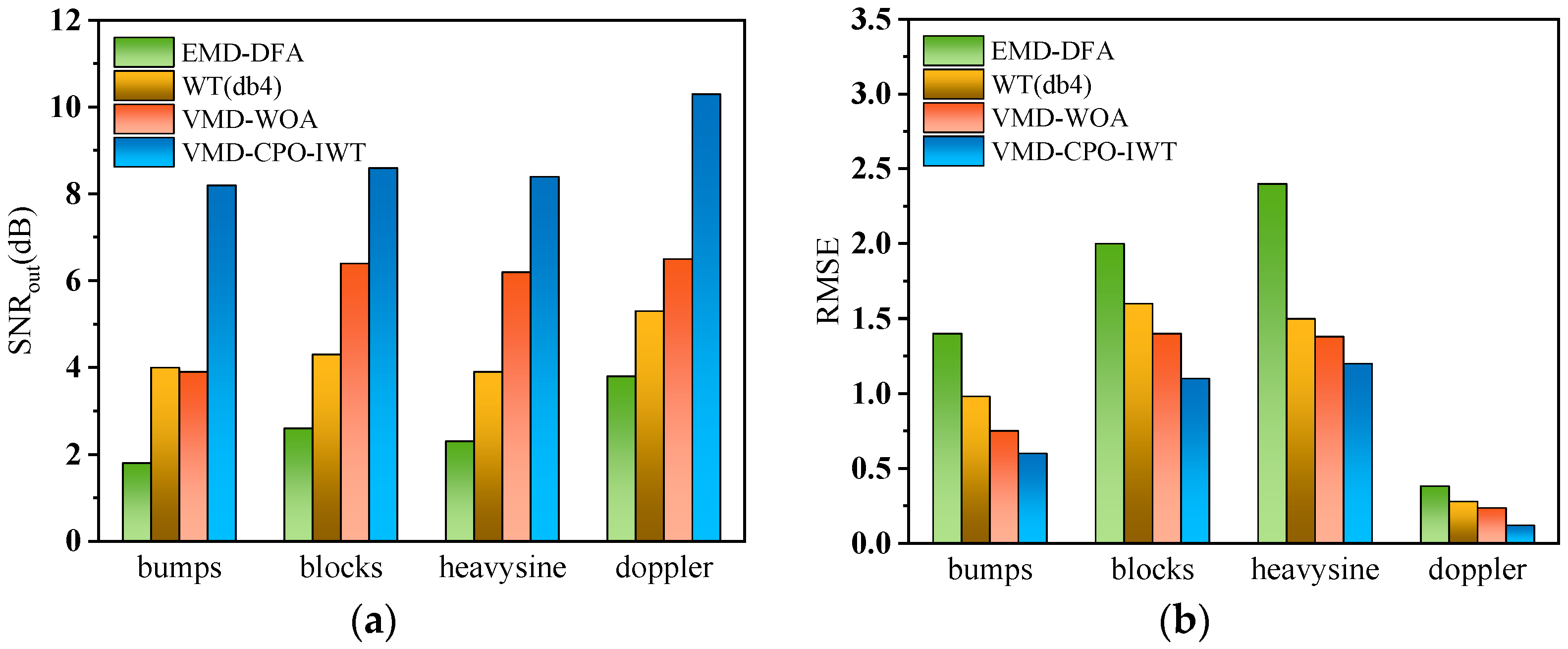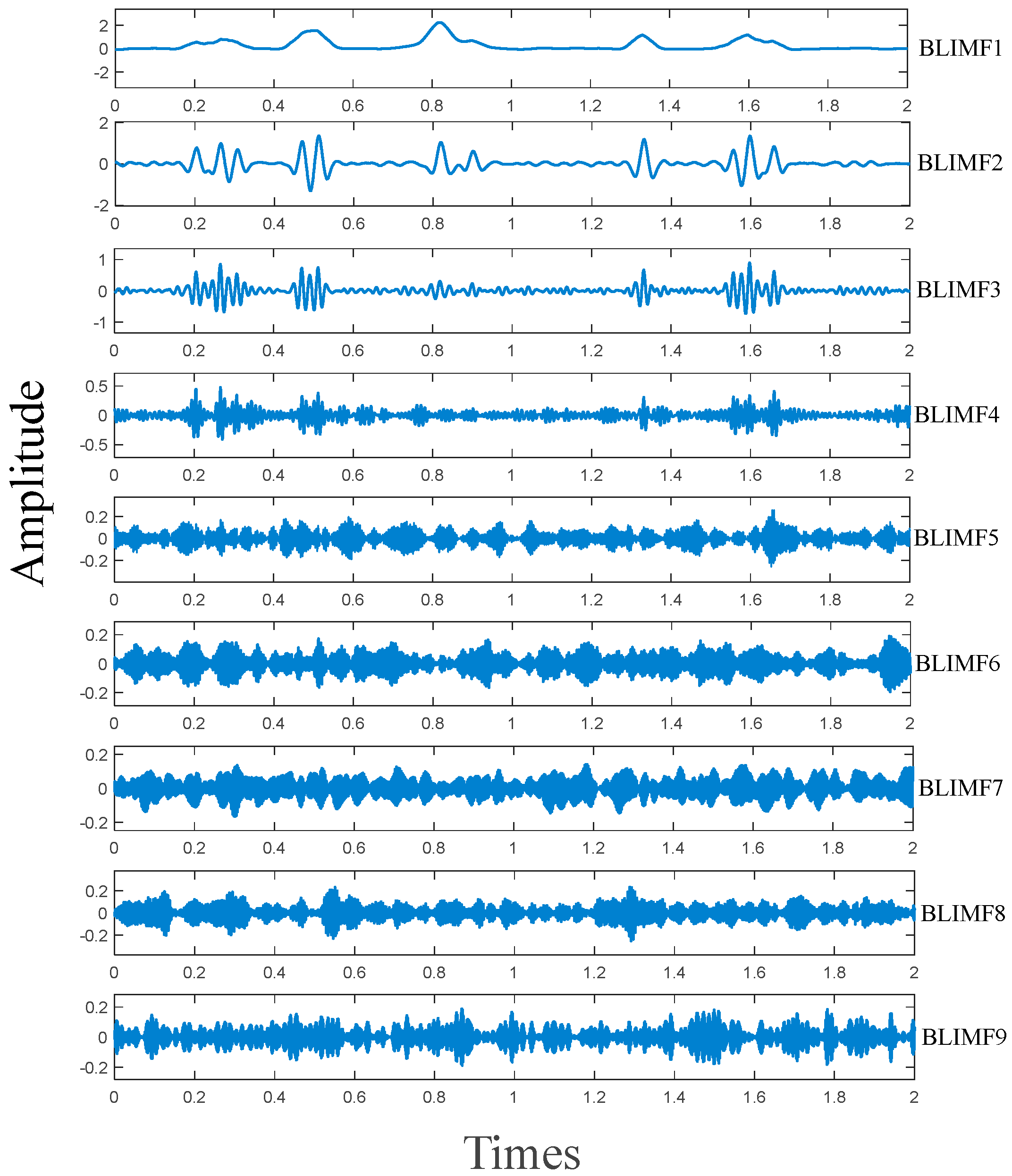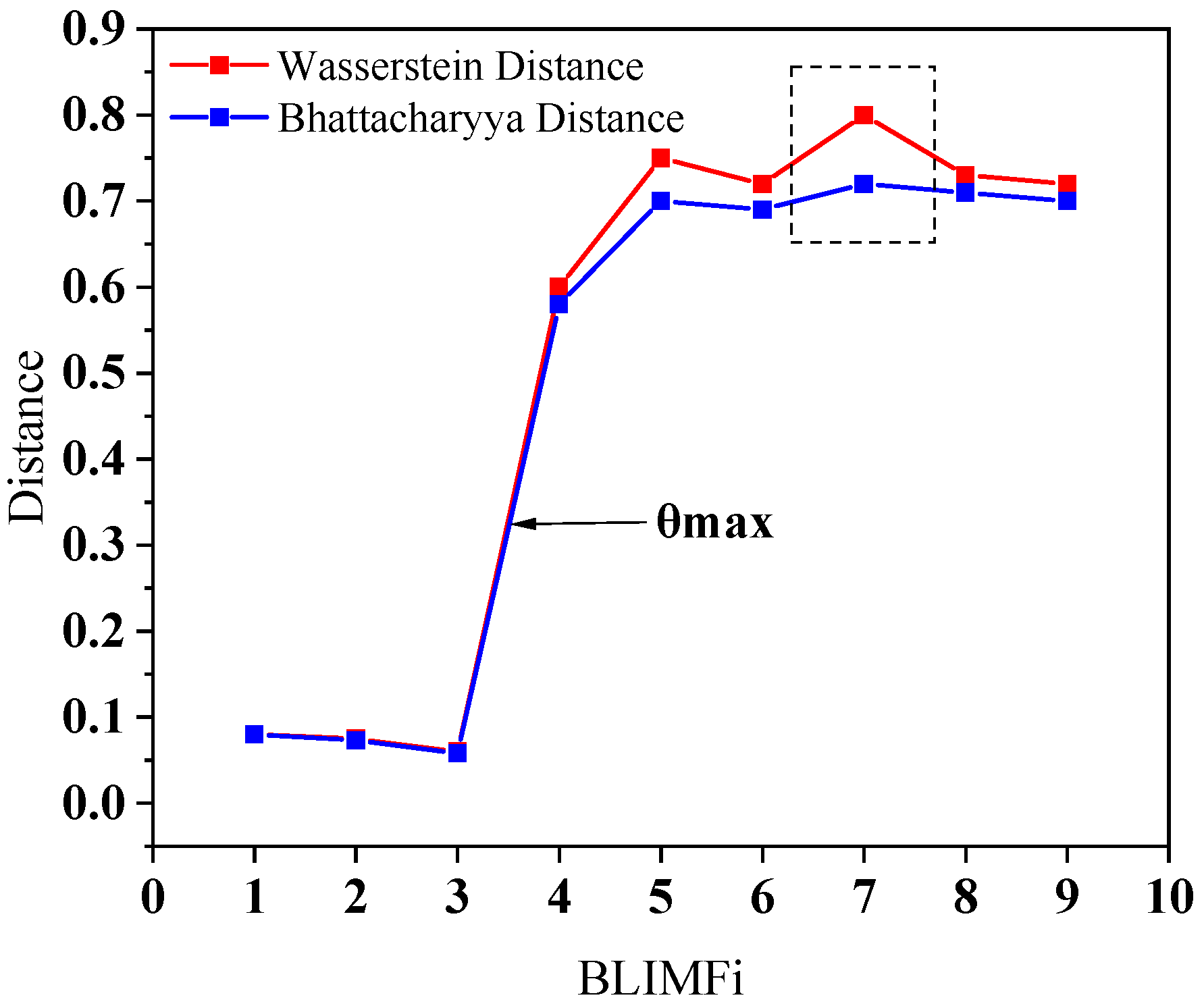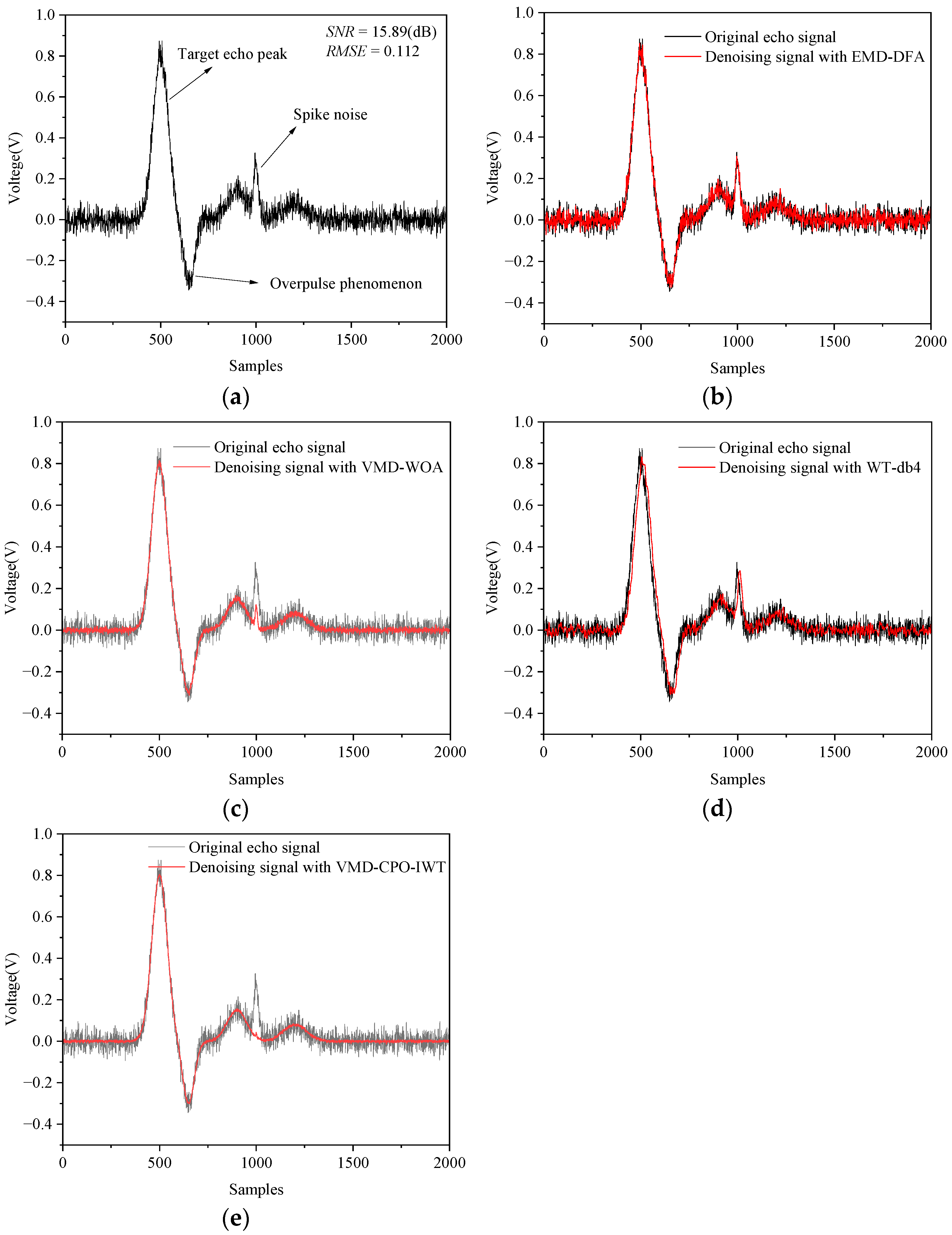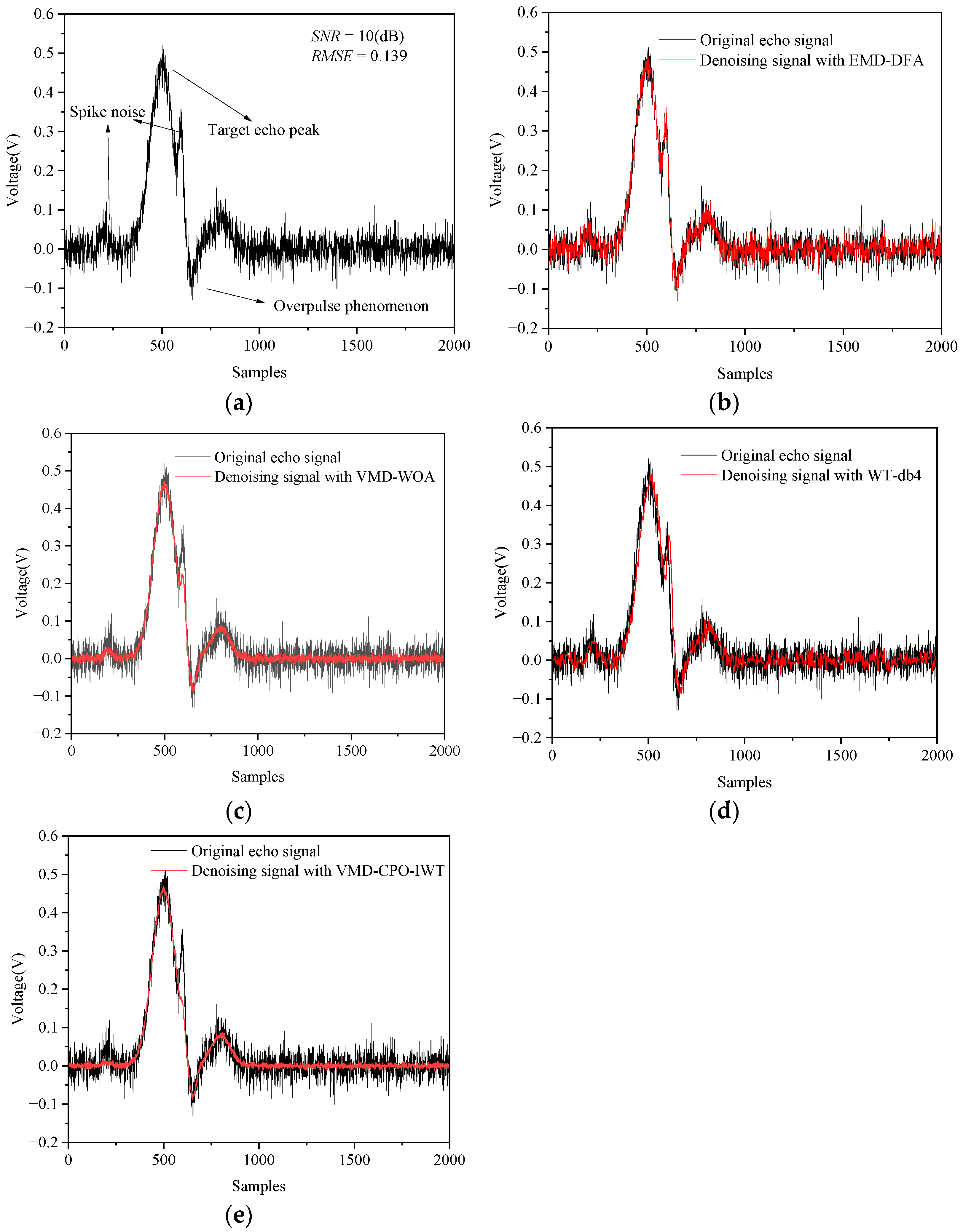1. Introduction
LiDAR is an integration of conventional radar technology and modern laser techniques, representing a powerful active remote sensing methodology. It offers distinct advantages, including high resolution, extensive detection range, and robust immunity to electromagnetic interference [
1,
2]. This technology plays a pivotal role in diverse applications such as atmospheric monitoring [
3,
4], target recognition [
5,
6], and 3D imaging [
7]. However, LiDAR echo signals are highly susceptible to solar background light, detector dark current, and amplifier thermal noise, making the weak echo signals even more difficult to recognize [
8,
9,
10]. The electronic thermal noise inherent in the system hardware is exacerbated under long operation or high temperature conditions, further affecting the detection accuracy [
11]. Moreover, at long distances and in environments with low
SNR, the environmental interference is enhanced and the echo power is reduced, resulting in echo signals that are highly susceptible to being annihilated in the noise. Therefore, the development of advanced noise reduction algorithms is crucial to improve the data quality and accuracy of LiDAR detection.
In recent years, several filtering algorithms applicable to LiDAR echo signal denoising have been extensively investigated, including the Fourier transform (FT), wavelet transform (WT), empirical mode decomposition (EMD), and VMD. These methods have demonstrated effectiveness under various operational scenarios. Among conventional signal processing approaches, FT extracts target signals by analyzing frequency distributions of noise and useful components. However, its inability to perform localized time-frequency analysis restricts its applicability to linear and stationary signals [
12]. For LiDAR signal exhibiting nonlinear and non-stationary characteristics, FT often yields unsatisfactory denoising performance with significant signal distortion. Wavelet transform decomposes noisy signals into weighted sums of wavelets at different scales, employing predetermined thresholds to filter noise-contaminated coefficients. While WT offers excellent time-frequency localization, its performance is constrained by wavelet basis selection limitations and poor adaptability [
13]. As an emerging denoising technique, EMD has gained widespread adoption in biomedical engineering, mechanical fault diagnosis, and audio processing [
14]. This method adaptively decomposes signals into band-limited intrinsic mode functions (BLIMFs), making it suitable for non-stationary and nonlinear signals. Nevertheless, EMD suffers from critical drawbacks, including mode mixing and end effects during decomposition, which adversely impact denoising outcomes. VMD, introduced by Dragomiretskiy and Zosso in 2014, represents a novel adaptive signal decomposition approach fundamentally distinct from EMD [
15]. VMD exhibits superior capabilities in processing nonlinear and non-stationary signals. Theoretically, whereas EMD employs recursive time-domain decomposition, VMD implements fully non-recursive frequency-based decomposition. Consequently, VMD not only overcomes mode-mixing issues inherent in EMD but also achieves enhanced filtering performance through its inherent Wiener filtering characteristics. VMD has been successfully implemented across multiple domains, including mechanical fault diagnosis, biomedical signal processing, and LiDAR signal enhancement [
16,
17,
18].
However, to fully leverage the advantages of VMD, two critical parameters must be determined: the number of decomposition modes
and the quadratic penalty term
. These parameters are typically selected within specified ranges. In previous studies, they were often determined empirically based on convenience [
19,
20,
21], substantially constraining VMD’s performance and potentially leading to inaccurate decomposition results. Several researchers have investigated methodologies for optimal parameter selection. Long et al. [
22] employed Particle Swarm Optimization (PSO) to identify optimal VMD parameters. Although PSO can yield suitable parameters, it exhibits tendencies toward local optima trapping and relatively slow convergence. Li et al. [
23] utilized the Whale Optimization Algorithm (WOA) to obtain optimal combinations of
and
. However, WOA’s performance is contingent upon initial population selection; inadequate coverage of the parameter space may prevent convergence to global optima. Gu et al. [
24] refined the adaptive mode selection criterion for VMD to determine decomposition levels. Nevertheless, this approach requires manual threshold calibration based on specific scenarios, introducing operational complexity and subjectivity.
Beyond parameter optimization, the essence of VMD-based signal filtering lies in selecting relevant modes for signal reconstruction after decomposition. When applying VMD to noisy data, it is imperative to discriminate between the physical nature of each mode—whether it constitutes pure signal, pure noise, or hybrid components [
25]. Zhou et al. [
26] employed correlation-based Euclidean distance to identify pertinent modes for signal reconstruction. However, for signals exhibiting complex dynamic characteristics, this metric fails to comprehensively characterize inter-modal relationships, consequently impairing mode identification efficacy. Zhang, Y. et al. [
27] adopted detrended fluctuation analysis (DFA) to establish thresholds distinguishing noise-dominant and signal-dominant BLIMFs. While DFA effectively measures long-range dependencies in non-stationary time series, it neglects correlations with simulated signals and lacks adaptability. Xinru Cao et al. [
28] implemented a correlation coefficient thresholding method for selectively filtering noise-contaminated BLIMFs. Nevertheless, threshold determination in this approach relies heavily on empirical trial-and-error, introducing substantial subjectivity in practical applications.
Aiming at the shortcomings of existing research, a denoising algorithm for pulsed laser echo signals based on parameter-optimized VMD is proposed. Firstly, the CPO is introduced to iteratively optimize the decomposition parameters of the classical VMD method, overcoming the limitation that traditional VMD cannot adaptively initialize parameters. Secondly, the Wasserstein distance is adopted as a criterion to discriminate between relevant and irrelevant modes, selecting the BLIMFs that meet the requirements for signal reconstruction. This approach improves the accuracy of relevant mode identification compared to the commonly used Bhattacharyya Distance (BD). Finally, the IWT denoising method is incorporated after signal reconstruction to further remove Gaussian white noise from the reconstructed signal, thereby enhancing the SNR. Simulations and experimental results verify that the proposed algorithm can effectively remove noise from echo signals and demonstrates strong robustness. It maintains good denoising performance even under low SNR conditions, improves the ranging accuracy of LiDAR systems, and possesses significant practical application value.
2. The Principle of LiDAR
A detailed schematic diagram of the LiDAR system utilized in this study is presented in
Figure 1. The system comprises a laser emission system, a laser receiving system, an optical system, and a control system. The laser emission system emits laser pulses at a wavelength of 905 nm. The laser receiving system captures the backscattered signals from the target. Collimation and focusing of the laser beam are accomplished by the optical system. Synchronization and subsequent signal processing are executed by the control system. The pulse laser echo power equation for a planar target is [
29,
30]:
where
is the pulse laser echo power,
is the optical window diameter,
is the distance between the lidar and the target,
is the one-way atmospheric attenuation coefficient,
,
is the atmospheric extinction coefficient,
is the laser wavelength,
is the system transmittance efficiency,
is the cross-sectional area of the laser beam on the target surface,
is the Lambertian target surface scattering coefficient,
,
is the hemispherical reflectivity of the target,
is the beam incidence angle,
represents the spatial distribution of the pulsed laser,
represents the spatial distribution of the laser emission pulse.
In LiDAR systems, the target-backscattered echo signal is highly susceptible to interference from electronic thermal noise and background optical noise. Under real-world conditions, these noise sources are typically complex, with each exhibiting distinct probability distributions. The actual noise energy can be modeled as the sum of multiple independent random noise components. According to the Central Limit Theorem, as the number of noise sources increases, their normalized aggregate tends to approximate a Poisson distribution [
31,
32]. Consequently, under multi-source noise interference, the composite noise can be characterized as Poisson-distributed. This premise forms the basis for formulating the received echo signal equation in LiDAR systems:
In the equation, represents the true echo signal, and denotes the Poisson noise induced by electronic thermal noise and background optical noise. The proposed joint denoising algorithm is designed to reduce and recover a high-fidelity denoised signal .
3. VMD-CPO-IWT Methodology
3.1. VMD Algorithm
The VMD algorithm, grounded in classical Wiener filtering, decomposes an input real-valued signal into a series of BLIMFs, each characterized by a specific center frequency [
15]. To estimate the bandwidth of each BLIMF while minimizing it under the constraint that the sum of all decomposed modes equals the original signal, the following constrained variational problem is formulated:
where
denotes the
k-th mode,
represents the center frequency of each mode,
is the number of decomposition modes,
indicates the convolution operator,
constitutes the analytic signal via Hilbert transform,
quantifies the bandwidth of the
k-th mode, and Equation (4) enforces the constraint condition for Equation (3).
To solve the constrained variational problem, a quadratic penalty term
and a Lagrangian multiplier
are introduced. The quadratic penalty term ensures signal reconstruction fidelity, while the Lagrangian multiplier enforces strict constraint satisfaction. By integrating these components, the original constrained variational formulation is transformed into an unconstrained optimization problem, yielding the following augmented Lagrangian function:
Herein, the weighting coefficient of the quadratic penalty term is typically derived from the Bayesian prior distribution of additive independent and identically distributed (i.i.d.) Gaussian noise that exhibits an inverse proportionality to the noise level in the signal. The quadratic penalty term ensures reconstruction fidelity under Gaussian noise contamination, whereas the Lagrangian multiplier guarantees strict enforcement of the constraint condition.
Consequently, the minimization problem in Equation (3) transforms into a saddle point search for the augmented Lagrangian function in Equation (5). VMD employs the Alternating Direction Method of Multipliers (ADMM) to solve this problem through iterative local optimizations. The preliminary update forms for
,
, and
are respectively given by [
15]:
The algorithm proceeds iteratively via Equations (4)–(6) until either the convergence criterion is satisfied or the maximum iteration count is reached, at which point the iteration terminates. The convergence condition requires satisfaction of the following inequality constraint:
where
enotes the Fourier spectrum of the
k-th mode,
represents the center frequency of each mode,
signifies the Fourier spectrum of the original signal,
is the noise tolerance parameter,
denotes the convergence criterion tolerance (generally set to
), and
indicates the iteration count.
3.2. CPO Algorithm
The CPO is a novel metaheuristic algorithm inspired by the distinctive defense mechanisms of crested porcupines. It dynamically adjusts search strategies through dual-mode operations—”Threat Perception” and “Defensive Tactics”—enabling rapid convergence toward potential optima during early stages while facilitating refined local exploitation in later phases [
33]. CPO addresses multi-dimensional optimization problems where each dimension corresponds to a minimization or maximization objective. The algorithm initiates by randomly initializing dimensions within the problem-specific search space, subsequently optimizing solutions through Equation (10):
where
denotes the population size (i.e., total number of individuals),
represents the
i-th candidate solution in the search space,
and
are the lower and upper boundaries of the search range, respectively, and
is a uniformly distributed random vector initialized between 0 and 1.
When employing the CPO to determine optimal VMD parameters, the operational procedure comprises the following steps:
(i) Global Exploration Phase
During this phase, the crested porcupine detects predators at considerable distance, deploying dual visual and auditory deterrent mechanisms.
Primary Defense Strategy: The porcupine erects and flutters its quills as a visual warning to predators. This behavior is mathematically modeled by the position update equation:
where
denotes the optimal solution of the function that determines the value of
t,
is a vector generated between the current crested porcupine (CP) and the population CP, and denotes the position of the predator at the first iteration.
is a random number drawn from a normal distribution, and
is a random value in the interval [0, 1].
Secondary Defense Strategy: The crested porcupine generates acoustic threats to further deter predators, mathematically modeled by the position update:
where
and
are two random integers drawn from the range [1,
N], and
are random values generated between 0 and 1.
(ii) Local Exploitation Phase
At this stage, predators are close to the crested porcupine, which will deploy olfactory and physical attacks against them.
Third Defense Strategy: The crested porcupine secretes a foul-smelling substance that diffuses through the surrounding area to prevent predators from advancing closer. Its mathematical model is:
where
is a random integer within [1,
N],
denotes the parameter controlling search direction,
represents the position of the
i-th individual at iteration
t,
is the defense factor,
is a random value in [0, 1],
signifies the odor diffusion factor.
Fourth Defense Strategy: When all preceding strategies fail, the crested porcupine launches physical attacks against predators. Its mathematical model is:
where
denotes the global optimum solution,
represents the position of the
i-th individual at iteration
t, signifies the predator position at the corresponding location,
and
are random variables uniformly distributed in [0, 1],
quantifies the inelastic collision force generated during physical assault.
3.3. Minimum Average Envelope Entropy (MAEE)
LiDAR echo signals demonstrate distinctive non-stationary and time-varying properties, challenging the efficacy of conventional fitness functions under complex operational conditions. Information entropy serves as a robust metric for evaluating signal sparsity, where higher entropy values directly indicate greater signal uncertainty. To enhance sparsity characterization, envelope entropy is introduced as an advanced measure that more accurately quantifies the sparse nature of raw signals [
34].
The average envelope entropy (AEE) is defined as the mean value of envelope entropy across all variational mode components obtained through VMD under specific parameters
and
. The AEE metric is employed as the fitness function during the CPO optimization process, with the MAEE serving as the ultimate optimization objective. This approach thereby optimizes the VMD parameters
and
, as formalized in Equation (15).
where
and
denote the optimal parameters,
represents the envelope entropy of each variational mode component, which can be computed via Equations (16) and (17).
where
is the sampling point, and
is the normalized value of the envelope
.
3.4. VMD-CPO Algorithm
To optimize the key parameters of VMD, we integrate the Crested Porcupine Optimizer, forming the VMD-CPO algorithm. The modal component number
and the quadratic penalty factor
have a significant impact on the decomposition results of VMD. When
is too small, the signal decomposition may be incomplete, and some components may overlap with other modes. When
is too large, over-decomposition and mode repetition may occur. When
is too small, the bandwidth of the decomposed modes may be too large, and some modes may overlap with others. When
is too large, the bandwidth of the decomposed modes may be too small, and some modes of the original signal may be lost [
35]. Therefore, the adaptability of the variational modal decomposition algorithm lies in how to obtain the optimal values of parameters
and
.
Based on CPO and MAEE, the details of the VMD-CPO algorithm are summarized as follows, with the process shown in
Figure 2.
Step 1: Initialize the CPO parameters and . Here, is set to 13 and is set to 8000 to avoid incomplete signal decomposition.
Step 2: Perform VMD calculations on LiDAR echo signals.
Step 3: Calculate the AEE for each position. When the AEE is lower than the current optimal fitness value, update the MAEE.
Step 4: Determine whether to terminate the iteration. If is less than (the maximum number of iterations), then let , and update the position of the crested porcupine population. Otherwise, terminate the iteration and save the optimal parameters.
3.5. WD
According to Bayesian theory, probability density functions (PDFs) can reflect differences between signal distributions [
25]. Therefore, we utilize kernel smoothing density functions to estimate the PDFs of each mode and the input signal. Relevant modes and irrelevant modes are distinguished by computing their similarity.
Commonly used similarity measurement methods can be divided into two categories: (1) the information-theoretic measures, including the Kullback–Leibler divergence (KLD), and (2) the geometric distance measures such as the Hausdorff distance, BD, etc. [
36]. Reference [
25] compares information-theoretic measures with geometric distance measures and demonstrates that the latter are more effective than the former. Comprehensively considering these factors, this paper adopts the WD as the similarity measurement method to distinguish relevant and irrelevant modes. The WD is an indicator measuring the similarity between two distributions, whose advantage lies in its ability to reflect the distance between distributions even when their support sets have no overlap or minimal overlap, while also being sensitive to outliers [
37]. The calculation formula for WD is:
where
is the set of all possible joint probability distributions of the marginal distributions of different data
and
. Sampling
from each possible joint probability distribution
yields a pair of samples
and
. Calculating the distance
between this pair of samples yields the corresponding expected value
. The lower bounds obtained for the expected value in the joint probability distribution
are WD.
The similarity measurement
between the input signal
and each mode
is defined as follows:
Relevant modes can be determined by evaluating the slope of distances between two adjacent PDFs and the input signal. The maximum slope
can be defined as:
The boundary index between relevant modes and irrelevant modes is defined as follows:
3.6. IWT
Compared with the hard thresholding method, the denoised signal processed by the soft thresholding method exhibits better smoothness [
38]. Therefore, this paper adopts the soft thresholding technique to recover useful signals concealed by noise:
where
represents the wavelet coefficients after decomposition, and
denotes the threshold.
Threshold selection is critical for wavelet denoising. Compared with the VisuShrink thresholding method [
39] and the Rigsure thresholding method [
40], the improved Stein’s unbiased risk estimate (ISURE) proposed in this paper offers a wider optimization range for optimal thresholds and exhibits reduced dependence on data volume.
Let
represent the noisy data to be denoised,
denote the pure signal data,
is the threshold-processed data, with signal length
. The mapping function
from the noisy data
to
is defined as follows:
According to the principle of Stein’s unbiased risk estimate (SURE) [
41], the estimated mean squared error (MSE) is derived as follows:
Here, Equation (25) is derived from Equation (23).
Substituting into Equation (24), the partial derivative of
with respect to
is computed to obtain the gradient value. The optimal threshold is then derived by optimizing the mean squared error estimate using gradient descent. However, Equation (24) exhibits significant limitations: it applies identical threshold values across all levels during multilevel wavelet decomposition, failing to adapt to multi-scale characteristics [
42]. Therefore, an improved method is proposed by generalizing the approach, substituting the data values
with wavelet coefficients as variables.
Let the high-frequency wavelet coefficients at the j-th level of the signal to be denoised be denoted as
. Among these, the high-frequency wavelet coefficients of the pure signal are
, and the high-frequency wavelet coefficients of the denoised signal are
.
The mapping function from the noisy wavelet coefficients
to the denoised coefficients
, and its formula is expressed as:
Lemma 1.
Let be a real-valued random variable, and consider an estimator of . Suppose the mapping h: is almost everywhere differentiable and satisfies, where . Then for every, the following equality holds:
Substituting
and
from Equation (26) into
,
and
in Equation (27), respectively, we finally obtain an estimate of
times the MSE deviation of the denoised coefficients and the pure signal coefficients:
The value of that minimizes Equation (27) for each layer is the threshold. This improvement provides a specific, accurate, and simple function expression for the last partial derivative in the estimation Equation (28), which facilitates the selection of optimization algorithms.
3.7. VMD-CPO-IWT Algorithm
Figure 3 illustrates the flowchart of the VMD-CPO-IWT algorithm. The specific procedural steps are as follows:
Step 1: Input the noisy original LiDAR echo signal .
Step 2: Set the optimization ranges for VMD parameters. Here, the range for the number of modes is [2, 15], and the range for the quadratic penalty factor is [200, 10,000]. Additionally, initialize the CPO model parameters: maximum iterations , initial population size .
Step 3: Decompose the signal using VMD. Calculate the fitness value for each search position. Save the minimum fitness value from each iteration.
Step 4: Iterate cyclically until reaching the maximum iterations, i.e., check if . If yes, terminate the iteration. Otherwise, set and continue iterating. Save the optimal parameters and best fitness value.
Step 5: Decompose the signal with VMD using the optimal parameters.
Step 6: Calculate the PDF of each mode and the input signal to obtain their WD. Screen relevant modes and reconstruct the signal.
Step 7: Perform IWT denoising on the reconstructed signal to further filter out Gaussian white noise.
5. Discussion
While this study has comprehensively demonstrated the efficacy of the proposed CPO-VMD-IWT algorithm for denoising single-point LiDAR echo signals, its foundational framework, rooted in adaptive signal decomposition and noise separation, opens up several promising avenues for future research. The potential extensions of this work are primarily in three directions:
Firstly, the exploration of cross-disciplinary applications. The core strength of the CPO-VMD-IWT method lies in its generalizability for processing nonlinear and non-stationary signals. This suggests its potential applicability beyond LiDAR, particularly in domains like biomedical engineering (e.g., for denoising electrocardiogram (ECG) or electroencephalogram (EEG) signals to isolate physiological artifacts) and geophysics (e.g., for enhancing seismic signals by suppressing ground-roll noise). Future work will involve validating the algorithm’s performance and potentially tailoring it to the specific characteristics of these diverse signal types.
Secondly, the adaptation for advanced 3D sensing systems. Modern Flash and scanning LiDAR systems generate massive datasets comprising thousands of independent echo signals from different pixels or points. The proposed method, which operates on a per-signal basis, is inherently suitable for such architectures. The primary challenge shifts from algorithmic principle to computational efficiency. A key future direction is the development of a high-throughput, parallel computing implementation (e.g., leveraging GPU acceleration) to enable real-time denoising across all channels, thereby significantly enhancing the quality and reliability of the entire 3D point cloud under challenging detection conditions.
Finally, a systematic investigation into the algorithm’s robustness under extreme environmental conditions. Although the method shows theoretical promise in handling complex disturbances, its performance under practical scenarios with significant atmospheric perturbations, such as fog, rain, or dust, requires rigorous empirical validation. Future work will include controlled laboratory experiments and extensive field tests across various weather conditions to quantitatively assess the algorithm’s limitations and strengths, ensuring its practicality for real-world applications in autonomous navigation and remote sensing.
Through these investigations, the CPO-VMD-IWT algorithm can evolve from a specialized solution for LiDAR denoising into a versatile and robust signal-processing platform with broad impact across multiple scientific and engineering disciplines.
6. Conclusions
This paper proposes a novel joint denoising algorithm named VMD-CPO-IWT for LiDAR echo signals. The method first employs CPO to optimize VMD parameters, including the number of modes and the quadratic penalty factor . Subsequently, the input signal is decomposed using the optimized VMD parameter combination, and relevant modes are selected for signal reconstruction based on the WD between decomposed modes and the original signal. Following these steps, an improved wavelet denoising method is further applied to the reconstructed signal to achieve enhanced performance. The practicality and accuracy of the proposed method were validated through denoising experiments on multiple simulated and real signals under various conditions. By denoising four typical nonlinear non-stationary signals (Bumps, Blocks, Heavysine, and Doppler), the performance of VMD-CPO-IWT was compared with several other algorithms. Results demonstrate that VMD-CPO-IWT outperforms others in both SNRout and RMSE. Particularly for the Doppler signal with SNRin = −5 dB, the processed SNRout reaches 10.3 dB, representing a 15.3 dB improvement, with an RMSE of only 0.118. Finally, comparative denoising experiments were conducted on echo signals using our self-developed LiDAR prototype. Experimental results prove that the proposed method effectively suppresses Gaussian white noise and high-frequency spike pulse noise, preserves useful signals, and enhances the quality of LiDAR echo signals. This approach can be applied to weak LiDAR echo signal detection, significantly improving subsequent threshold timing discrimination accuracy.
